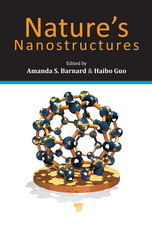A new book, which explores how nature's own laboratory has been producing some of the world's most advanced nanomaterials for millions of years, has been released.
 Nature’s Nanostructures, edited by CSIRO scientists Dr Amanda Barnard and Dr Haibo Guo.
Nature’s Nanostructures, edited by CSIRO scientists Dr Amanda Barnard and Dr Haibo Guo.
Nature's Nanostructures, edited by CSIRO scientists Dr Amanda Barnard and Dr Haibo Guo, focuses on the animals, minerals and extra-terrestrial bodies that have been producing nanomaterials for millennia.
In the first collection of its kind, each chapter charts the complex characteristics of different nanomaterials, including the iridescent scales on the exoskeletons of beetles, magnetic particles in the beaks of pigeons and gold particles found in ores.
The book brings together studies of entomology, geology, astronomy, physics, chemistry, molecular biology and health to build a complete picture of naturally occurring nanomaterials.
"I think is it generally assumed that nanomaterials are a relatively new phenomenon but some nanoparticles have been present in animals and minerals for millions of years and are a natural occurrence," says Dr Amanda Barnard, leader of the Virtual Nanoscience Laboratory at CSIRO.
"This book uniquely charts the diversity of these naturally occurring materials. It is both humbling and comforting to realise that nature did it first and that nanomaterials are not as new as we think," she adds.
New CSIRO research on beetles and the reflective qualities of their shells is included in the book. The chapter titled 'Photonic Crystals in Beetles' explores 3D crystals produced by opal weevils and how these nanostructures not only create vivid structural colours, but also reflect light at virtually any angle.
The book also contains research, produced by scientists in the US and Germany, into the different levels of magneto-reception found in the beaks of homing pigeons and how the nanostructures in their beaks work as an efficient magnetic field amplifier.
"By studying how these nanomaterials are naturally produced we will be one step closer to being able to replicate these materials in a lab environment and exploring their potential applications in science and industry," says Dr Barnard.